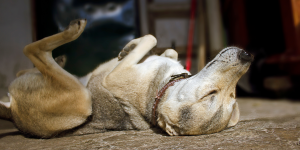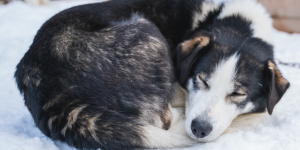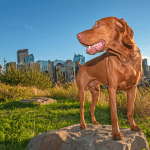How Much Sleep Do Dogs Need?
It may be surprising to learn that our four legged companions tend to sleep a lot longer than you might think. However, rather than sleeping in long stretches, like people do, dogs tend to nap in shorter bursts throughout the day and night. How long do dogs sleep each day and how much sleep do dogs need to stay healthy? Read our Holidays4Dogs article to find out more.
 The ancestors of humans, with limited night vision, would hunt during the day. Dogs, however, have far better vision in low light. Therefore, dogs in the wild generally hunt during the night.
The ancestors of humans, with limited night vision, would hunt during the day. Dogs, however, have far better vision in low light. Therefore, dogs in the wild generally hunt during the night.
For our human ancestors, resting for long periods during the night had its advantages. However, dogs were able to take naps whenever they could, including through periods of daylight.
The modern day dog has, to a certain extent, adapted to the way humans live. As a result, they will generally settle throughout the night while their owners sleep.
This does not mean to say they sleep continuously, however – many will get up numerous times to stretch, scratch, or wander around. In addition, they will doze for several periods during the day time too.
How long do dogs sleep for during each 24 hour period?
In one example of research on the subject, puppies aged 16 weeks slept for an average of 11.2 hours in any 24 hour period. Adolescent dogs in the study slept for an average of 10.8 hours. As a comparison, humans sleep averagely for 7-8 hours during the same period.
What if my dog doesn’t get enough sleep?
 There is little research on the subject of sleep deprivation in dogs. However, there is some evidence to suggest, not getting enough rest can have similar effects in dogs, as it does in people.
There is little research on the subject of sleep deprivation in dogs. However, there is some evidence to suggest, not getting enough rest can have similar effects in dogs, as it does in people.
Sleep deprivation can affect, amongst other things, emotional performance and, subsequently, their overall welfare.
Lack of quality rest has also been shown to cause decreased learning ability in dogs. For example, not getting enough rest after having an operation, can mean healing takes longer.
If a dog is not getting enough meaningful rest he may show the following signs;-
-
Reactive to stressful situations.
-
Irritability and mood swings, including a possible increase aggressive type behaviours.
How to help your dog get quality rest.
-
Provide your dog with a bed somewhere quiet i.e. not in a thoroughfare of the house. Covered crates provide a cosy, den-like feel, which most dogs love.
-
Try not to disturb your dog if he is taking a nap. In addition, don’t let children constantly pester puppies, or dogs, as this could discourage them from resting. This is especially important from dogs recovering from illness, or surgery.
-
Exercise has shown to be helpful in inducing quality sleep in people and there is no reason why this should not be the same for dogs.
Canine sleeping positions.
Upside down!
This is often a favourite sleeping position of puppies. However, adult  dogs will also frequently sleep on their backs with legs sprawled in the air and heads flopped to one side.
dogs will also frequently sleep on their backs with legs sprawled in the air and heads flopped to one side.
Resting in this way, helps the dog to cool down by exposing his under belly.
Here, there is less fur and, additionally, it means the pads of the feet are also exposed to the air. The pads of a dog’s fee are the only place on the body that can perspire.
It often points to a contented dog too. One that feels safe in his environment enough to expose his soft underbelly.
The ‘hat’.
This sleeping position is when the dog curls up in a tight ball – commonly with the nose tucked under the tail. Dogs living in colder climes, such as sled dogs, often sleep in this way as a means of conserving heat. Warm breath expired from the nostrils helps keep the dog’s under body warm. 
Canine behaviour experts consider this to be a position of protection. It keeps the dog’s vulnerable organs less exposed to predators.
Dogs who rest in this way may be attempting to feel more secure in their surroundings. This way of sleeping can sometimes be seen in dogs who are unfamiliar with their environment.
Dogs who sleep in this position don’t have such good sleep since their bodies are less relaxed – this supports the theory that when resting in this position, a dog is more on guard for potential external threat.
Flat out.
Dogs that slumber on their sides, with their legs stretched out are feeling more relaxed. This position provides more restorative sleep. You may notice your dog twitching, yelping and paddling his legs – indicating that he is in the REM stage of sleep. Often its the chosen position by a dog that is content and tired.
Ready for action!
On the other hand, some dogs will nap with while lying in a sphinx style position. Back legs are tucked under, front legs stretched forward and their head resting between the paws, or one paw resting on the other.
 A dog who naps in this position, is likely to be only resting his eyes. As a result, he can be up on his feet at a moments notice.
A dog who naps in this position, is likely to be only resting his eyes. As a result, he can be up on his feet at a moments notice.
Final thoughts.
No matter what position your dog chooses to nap in, it is always very important not to disturb, or startle him, or her.
Any young children in the household should understand this rule too.
Conclusion.
Many dogs will appear to be sleeping deeply, but they are adept at waking rapidly, ready and alert to danger. This is why many owners may wonder if their dog sleeps with one eye open! A dog that appears sound asleep, can often hear the sound of a rustling crisp packet and be at scene in about an eighth of a second!
However, just like people, dogs need deep, restful sleep to maintain good health. So, it really is true you should let sleeping dogs lie.


